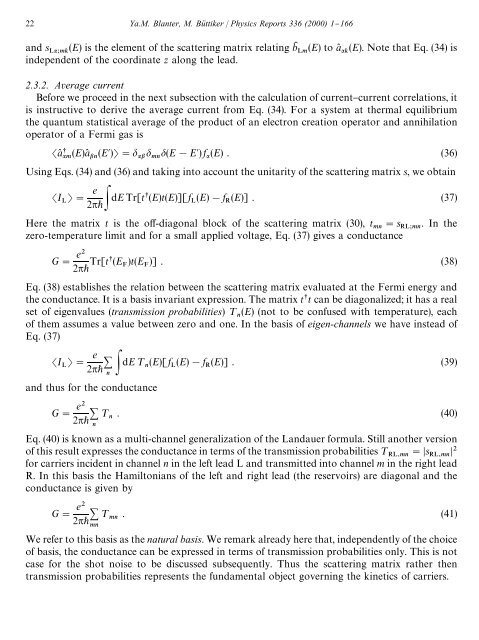shot noise in mesoscopic conductors - Low Temperature Laboratory
shot noise in mesoscopic conductors - Low Temperature Laboratory
shot noise in mesoscopic conductors - Low Temperature Laboratory
You also want an ePaper? Increase the reach of your titles
YUMPU automatically turns print PDFs into web optimized ePapers that Google loves.
22 Ya.M. Blanter, M. Bu( ttiker / Physics Reports 336 (2000) 1}166<br />
and s _ (E) is the element of the scatter<strong>in</strong>g matrix relat<strong>in</strong>g bK (E) toa( (E). Note that Eq. (34) is<br />
<strong>in</strong>dependent of the coord<strong>in</strong>ate z along the lead.<br />
2.3.2. Average current<br />
Before we proceed <strong>in</strong> the next subsection with the calculation of current}current correlations, it<br />
is <strong>in</strong>structive to derive the average current from Eq. (34). For a system at thermal equilibrium<br />
the quantum statistical average of the product of an electron creation operator and annihilation<br />
operator of a Fermi gas is<br />
a( (E)a( (E)" (E!E) f (E) . (36)<br />
Us<strong>in</strong>g Eqs. (34) and (36) and tak<strong>in</strong>g <strong>in</strong>to account the unitarity of the scatter<strong>in</strong>g matrix s, we obta<strong>in</strong><br />
I "<br />
e<br />
2 dE Tr[t(E)t(E)][ f (E)!f (E)] . (37)<br />
<br />
Here the matrix t is the o!-diagonal block of the scatter<strong>in</strong>g matrix (30), t "s . In the<br />
_<br />
zero-temperature limit and for a small applied voltage, Eq. (37) gives a conductance<br />
G" e<br />
2 Tr[t(E )t(E )] . (38)<br />
<br />
Eq. (38) establishes the relation between the scatter<strong>in</strong>g matrix evaluated at the Fermi energy and<br />
the conductance. It is a basis <strong>in</strong>variant expression. The matrix tt can be diagonalized; it has a real<br />
set of eigenvalues (transmission probabilities) ¹ (E) (not to be confused with temperature), each<br />
<br />
of them assumes a value between zero and one. In the basis of eigen-channels we have <strong>in</strong>stead of<br />
Eq. (37)<br />
I "<br />
e<br />
2 <br />
dE ¹ (E)[ f (E)!f (E)] . (39)<br />
<br />
and thus for the conductance<br />
G" e<br />
2 ¹ . (40)<br />
<br />
<br />
Eq. (40) is known as a multi-channel generalization of the Landauer formula. Still another version<br />
of this result expresses the conductance <strong>in</strong> terms of the transmission probabilities ¹ "s <br />
<br />
for carriers <strong>in</strong>cident <strong>in</strong> channel n <strong>in</strong> the left lead L and transmitted <strong>in</strong>to channel m <strong>in</strong> the right lead<br />
R. In this basis the Hamiltonians of the left and right lead (the reservoirs) are diagonal and the<br />
conductance is given by<br />
G" e<br />
2 ¹ . (41)<br />
<br />
<br />
We refer to this basis as the natural basis. We remark already here that, <strong>in</strong>dependently of the choice<br />
of basis, the conductance can be expressed <strong>in</strong> terms of transmission probabilities only. This is not<br />
case for the <strong>shot</strong> <strong>noise</strong> to be discussed subsequently. Thus the scatter<strong>in</strong>g matrix rather then<br />
transmission probabilities represents the fundamental object govern<strong>in</strong>g the k<strong>in</strong>etics of carriers.
















